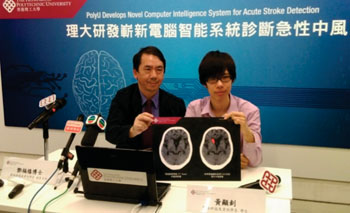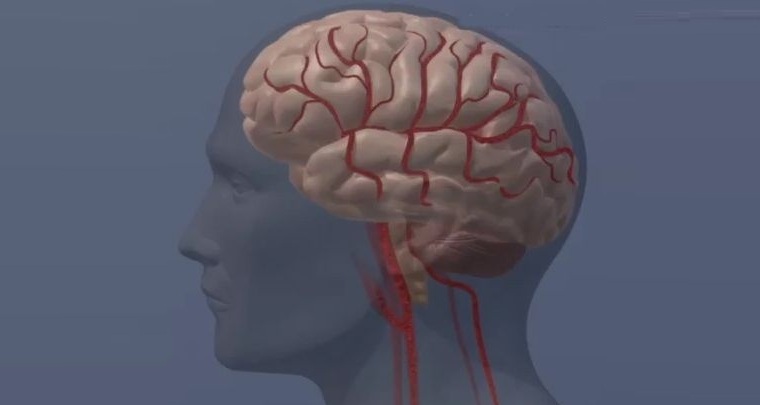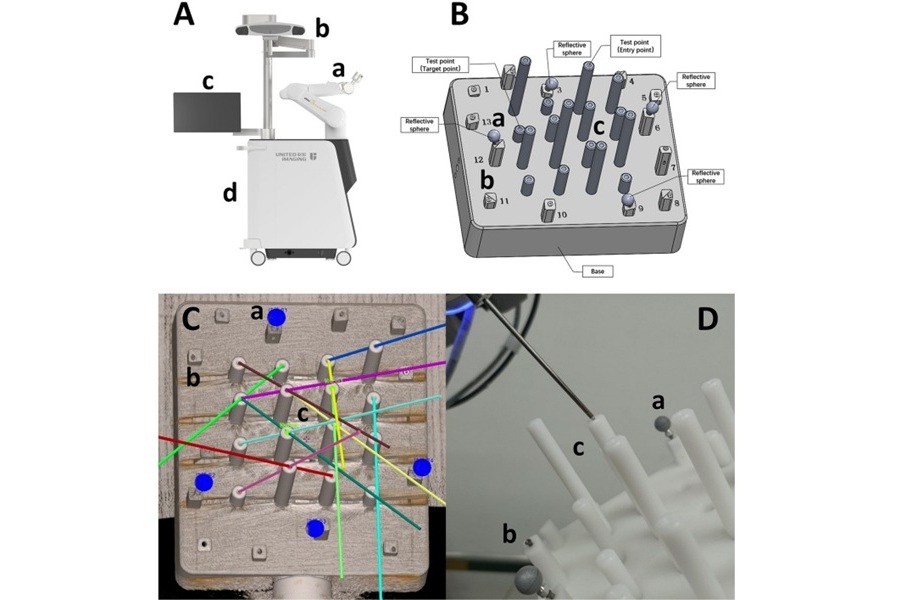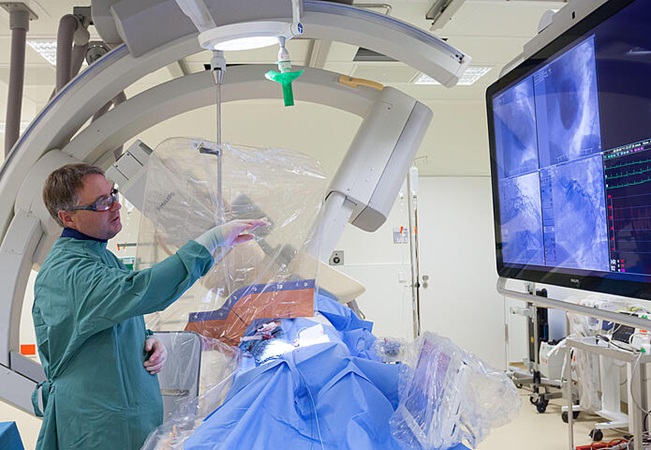Computer Intelligence Detects Acute Strokes
|
By HospiMedica International staff writers Posted on 27 May 2015 |

Image: Dr. Fuk-hay Tang (left) presenting the CAD system (Photo courtesy of Yvonne Lou/Hong Kong Polytechnic University).
Computer-aided detection (CAD) technology combines sophisticated calculations, artificial intelligence, and pathology to help medical professionals accurately diagnose stroke.
CAD stroke technology, developed by researchers at the Hong Kong Polytechnic University (PolyU; Hong Kong), is a system that analyzes computed tomography (CT) brain scans to identify suspect regions in the brain. When blood flow to the brain is blocked, an area of the brain decreases in density due to insufficient blood flow, pointing to a possible ischemic stroke. The first part of the system is thus an algorithm for automatic extraction of areas of circular adaptive region of interest (CAROI), which reads and analyzes 80–100 X-rays slices.
The second part the CAD stroke system is an artificial neural network that performs automated reasoning and sophisticated calculations and comparisons to locate areas suspected of insufficient blood flow. It detects where the images look abnormal, highlighting them for doctors’ review; such abnormalities include loss of insular ribbon, loss of sulcus, and signs of a dense middle cerebral artery (MCA). Since the system is able to detect subtle change in density, it is also able to detect hemorrhagic stroke, which is presented as increase in tissue density.
The detection accuracy is 90%, which is as high as that conducted by specialists, but at a much reduced time of just three minutes. False-positive and false-negative cases, and other less serious conditions that mimic a stroke can also be ruled out, allowing a fully-informed decision to be made. The CAD system is also equipped with a built-in artificial intelligence (AI) feature, which helps it to learn by experience. With every scan passing through, along with feedback from stroke specialists, the application improves its accuracy over time.
“Providing treatment to acute stroke patients within the golden hours of stroke treatment, i.e., three hours of stroke onset, is vital to saving lives. However, stroke specialists do not work around the clock, increasing the risk of misdiagnosis and delayed diagnosis of acute stroke,” said Fuk-hay Tang, PhD, of the department of health technology and informatics. “This novel system, which analyses brain scans, could help save lives by assisting non-specialists in diagnosis by providing them a second opinion. Timely diagnosis and treatment within three hours of stroke onset also minimizes damage.”
Related Links:
Hong Kong Polytechnic University
CAD stroke technology, developed by researchers at the Hong Kong Polytechnic University (PolyU; Hong Kong), is a system that analyzes computed tomography (CT) brain scans to identify suspect regions in the brain. When blood flow to the brain is blocked, an area of the brain decreases in density due to insufficient blood flow, pointing to a possible ischemic stroke. The first part of the system is thus an algorithm for automatic extraction of areas of circular adaptive region of interest (CAROI), which reads and analyzes 80–100 X-rays slices.
The second part the CAD stroke system is an artificial neural network that performs automated reasoning and sophisticated calculations and comparisons to locate areas suspected of insufficient blood flow. It detects where the images look abnormal, highlighting them for doctors’ review; such abnormalities include loss of insular ribbon, loss of sulcus, and signs of a dense middle cerebral artery (MCA). Since the system is able to detect subtle change in density, it is also able to detect hemorrhagic stroke, which is presented as increase in tissue density.
The detection accuracy is 90%, which is as high as that conducted by specialists, but at a much reduced time of just three minutes. False-positive and false-negative cases, and other less serious conditions that mimic a stroke can also be ruled out, allowing a fully-informed decision to be made. The CAD system is also equipped with a built-in artificial intelligence (AI) feature, which helps it to learn by experience. With every scan passing through, along with feedback from stroke specialists, the application improves its accuracy over time.
“Providing treatment to acute stroke patients within the golden hours of stroke treatment, i.e., three hours of stroke onset, is vital to saving lives. However, stroke specialists do not work around the clock, increasing the risk of misdiagnosis and delayed diagnosis of acute stroke,” said Fuk-hay Tang, PhD, of the department of health technology and informatics. “This novel system, which analyses brain scans, could help save lives by assisting non-specialists in diagnosis by providing them a second opinion. Timely diagnosis and treatment within three hours of stroke onset also minimizes damage.”
Related Links:
Hong Kong Polytechnic University
Channels
Surgical Techniques
view channel
Ablation Reduces Stroke Risk Associated with Atrial Fibrillation
Atrial fibrillation (AFib) greatly increases the risk of stroke, blood clots, heart failure, and death, and millions of people in the U.S. are expected to be affected in the coming years.... Read more
Optical Tracking Method Identifies Target Areas in Robot-Assisted Neurosurgery
Epilepsy occurs when nerve cells misfire and produce uncontrolled electrical bursts in the brain, leading to seizures. While most patients respond to medication, about 30% require more advanced intervention.... Read morePatient Care
view channel
Revolutionary Automatic IV-Line Flushing Device to Enhance Infusion Care
More than 80% of in-hospital patients receive intravenous (IV) therapy. Every dose of IV medicine delivered in a small volume (<250 mL) infusion bag should be followed by subsequent flushing to ensure... Read more
VR Training Tool Combats Contamination of Portable Medical Equipment
Healthcare-associated infections (HAIs) impact one in every 31 patients, cause nearly 100,000 deaths each year, and cost USD 28.4 billion in direct medical expenses. Notably, up to 75% of these infections... Read more
Portable Biosensor Platform to Reduce Hospital-Acquired Infections
Approximately 4 million patients in the European Union acquire healthcare-associated infections (HAIs) or nosocomial infections each year, with around 37,000 deaths directly resulting from these infections,... Read moreFirst-Of-Its-Kind Portable Germicidal Light Technology Disinfects High-Touch Clinical Surfaces in Seconds
Reducing healthcare-acquired infections (HAIs) remains a pressing issue within global healthcare systems. In the United States alone, 1.7 million patients contract HAIs annually, leading to approximately... Read moreHealth IT
view channel
Printable Molecule-Selective Nanoparticles Enable Mass Production of Wearable Biosensors
The future of medicine is likely to focus on the personalization of healthcare—understanding exactly what an individual requires and delivering the appropriate combination of nutrients, metabolites, and... Read moreBusiness
view channel
Philips and Masimo Partner to Advance Patient Monitoring Measurement Technologies
Royal Philips (Amsterdam, Netherlands) and Masimo (Irvine, California, USA) have renewed their multi-year strategic collaboration, combining Philips’ expertise in patient monitoring with Masimo’s noninvasive... Read more
B. Braun Acquires Digital Microsurgery Company True Digital Surgery
The high-end microsurgery market in neurosurgery, spine, and ENT is undergoing a significant transformation. Traditional analog microscopes are giving way to digital exoscopes, which provide improved visualization,... Read more
CMEF 2025 to Promote Holistic and High-Quality Development of Medical and Health Industry
The 92nd China International Medical Equipment Fair (CMEF 2025) Autumn Exhibition is scheduled to be held from September 26 to 29 at the China Import and Export Fair Complex (Canton Fair Complex) in Guangzhou.... Read more














